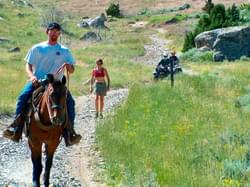




So what makes a trail wholly sustainable? According to Tom Crimmins there are four keys aspects: Resource Sustainability, Economic Sustainability, Experience Sustainability, and Political Sustainability
by Karen Umphress, Owner, UP! Outside

If you ask Tom Crimmins what makes a trail sustainable, he will first tell you that the trail provides for protection for natural resources. He will then tell you that it means much more, such as the trail being operated cost effectively, that it is maintained efficiently, and that it will continue to enhance the recreation experience over time. Tom should know, having worked for the U.S. Forest Service for over 30 year. He has specialized in recreation, particularly off-highway vehicle recreation, but his principles can be applied to all types of recreation situations.
Catch phrase. Everyone uses the term, but without a clear understanding of the whole concept.
So what makes a trail wholly sustainable? According to Tom Crimmins there are four keys aspects:
Resource sustainability is understood by most people as trails are not harmful to our environment and which protect our natural resources. However, it is important to remember that all trails, even the most sustainable, require some degree of maintenance yearly; even if it is just a quick inspection to make sure everything is still working well.
What makes a trail economically sustainable? Besides low maintenance costs, an economically sustainable trail is one that over time will give you a return on the investment in construction and maintenance of the trail. This trail will not be the cheapest to create. But the up-front costs that are put into the trail will pay for themselves several times over with the decreased costs in both time and money than a less well engineered trail. And when you are paying a lot for the maintenance of existing trails, you are not spending the money creating new trails.
Political sustainability is how happy the community will be to have this trail. The way that Tom describes this form of sustainability is NIMBYISM— Or the Not In My Back Yard— Syndrome. Lots of people like to use trails, but as soon as you talk about putting one in near existing homes, NIMBYISM pops up. People will tell you that their property values will go down, that trespass issues will go up, that trail users will use the trail to be able to plunder homes along the trail route.
For instance, I was talking to a gentleman from the next town where a rail trail is being considered. He is very much against the trail. He is unhappy that the trail will be running past his property. A rail line was fine, he said. “The trains went by at high speeds and didn’t stop to wander around our property. But with a trail there, people will now have access to our property where we won’t be able to see them. They will have the ability to trespass on our property easier. We won’t know what they are doing back there.”
In another case, people were very upset about an OHV park going in near their town. During all of the city and county discussions they testified that their property values would decrease, their town would see higher crime rates, and their children would no longer be safe. They also wrote about their fears in forums and in letters to the editor.
In both cases, the fears did not come to pass. The trails were created, trespassing did not go up, crime did not go up, and the children stayed safe. However, there can still be a perceived vulnerability felt by those who have trails going by their property. There is a balance of people for and against each trail that will need to be weighed.
Politically sustainable trails are the ones where more people accept the access and understand that most people don’t trespass because of the trail. If this type of understanding is not there for most of the people, then trail re-location should be a serious consideration. As Tom says, “They have moved airports because enough people complained.”
Experience sustainability begins when planning the trail for level of difficulty and for a specific purpose. An easiest trail where people can go slow and enjoy the countryside will need to be designed and maintained completely differently that a tough single-track trail designed to challenge a horseback rider, mountain biker, or dirt bike rider. The line of sight will be longer or shorter. Obstacles may be left in the trail for more difficult trails. Tread paths may need to be widened or narrowed. And each time the recreationist uses the trail, they will continue to experience the same pleasure as the first time they used the trail.
And in the end, what we need is for all of the people who recreate in our outdoors have as many and more quality opportunities, for their type of recreation, than they have now. This is true Trail Sustainability.
935 views • posted 05/30/2018